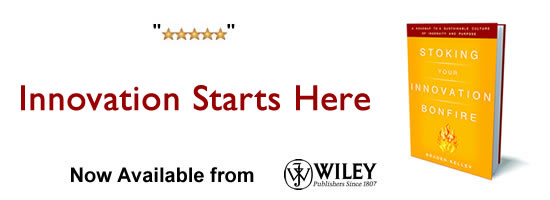You Must Define This Term to De-Risk Innovation
 Meaningful innovation inherently involves risk. If the initiative you are working on has no risk of failure, it likely is either not very innovative or not very meaningful. While the relationship between risk and innovation is widely acknowledged, few organizations properly define and communicate what acceptable failure is for their innovation program. The definition of acceptable failure for innovation initiatives is highly nuanced for each organization based on its evolving political, environmental, social, cultural, and operating constraints.
Meaningful innovation inherently involves risk. If the initiative you are working on has no risk of failure, it likely is either not very innovative or not very meaningful. While the relationship between risk and innovation is widely acknowledged, few organizations properly define and communicate what acceptable failure is for their innovation program. The definition of acceptable failure for innovation initiatives is highly nuanced for each organization based on its evolving political, environmental, social, cultural, and operating constraints.
Adopting consensus thoughts on acceptable failure is insufficient. Defining acceptable failure for your organization is critical. Â
Fail fast, fail often, fail cheap – these mantras are frequently found in innovation literature with some touting the necessity and other cautioning about the perils. For instance, Harvard Business Review has several articles touching on the topic including the necessity of failure, intelligent failure, getting teams to fail more, decreasing the cost of failure,increasing return on failure, and the perils of fail fast, fail often for breakthrough ventures. The Economist also addresses the potential value to be gained from managing failure well.
I believe much of this guidance on increasing the value from failure misses the nuance of what is acceptable failure for different types of organizations.
For example, failing fast may be completely unacceptable to a professional services organization if it compromises its reputation or damages a client relationship. Failing cheaply may be unacceptable to the head of a government agency if the method or outcomes of the failure result in a Congressional investigation or in a decrease in future funding for programs.
Defining acceptable failure is critical for de-risking innovation activities for individuals. Lowering the risk of innovating for the individual is a precondition to developing a culture of innovation.
Let’s briefly look at different archetypes of organizations and how their definitions of acceptable failure may differ:
- Venture-backed start-ups: These companies are incentivized to achieve hyper growth and capture market share. They are working with investor money. Those investors have portfolios that spread risk across many companies. Acceptable failure will tend towards aggressive moves designed to achieve large returns even if those moves are highly risky. Unacceptable failure will likely be defined by cautious expansion unlikely to achieve desired venture capital returns.
- High margin product or software companies: Resources are available to invest in new product development that creates new markets (e.g. Apple iPhone, Keurig coffee makers, Intuit). These companies can run classic prototype experiments with customers. Acceptable failure may be defined as an experiment that is run with limited budget that obtains clear feedback from customers and results in lessons that can be applied to the next product iteration even if the initial prototype is not launched to market.
- Innovation organizations and research laboratories: These entities are specifically funded to drive breakthrough, non-linear innovations for companies and society. Acceptable failure is likely to be defined by the nature of the gains being sought and the process used to pursue the research. For example, if a program fails, it may still be deemed acceptable if in the pursuit of a substantial potential benefit, the program was pursued in a robust way extracting interim learnings and only continuing funding for as long as the likelihood of future success was warranted.
- Low margin professional services companies: With limited funds to invest in creating new markets and products, these companies often focus on collaborative innovation with clients and the value-added combination of multiple existing services. Acceptable failure may be defined as initiatives that do not require substantial investment in advance of revenue generation and fail in a way that does not compromise the company’s reputation or client relationships.
- Government agencies: Innovation is required to continue advancing the delivery of citizen services. Failure is notably difficult for agencies that operate under constrained budgets and in divisive political environments. Defining acceptable failure will require a candid discussion with key internal and external stakeholders but could include limits on the investment spent on the experiments, bimodal innovation that validates new approaches without compromising core mission delivery, and frequent documentation of lessons learned and justification for continued funding as projects progress to maximize the societal return on any potential failure.
There are many organizations that do not fall neatly into the categories above nor do the straw man definitions presented apply to all entities or contain sufficient detail to be actionable. These categories are intended to begin framing how different types of organizations may have vastly different definitions of acceptable failure. Defining acceptable failure requires a difficult and candid conversation both within an organization and with an organization’s key external stakeholders (e.g. investors, regulators, customers, partners, clients, citizens).
For an excellent example of defining and communicating acceptable failure, read DARPA’s (the Defense Advanced Research Projects Agency’s) report Innovation at DARPA. DARPA makes it clear to all internal and external stakeholders what is expected in terms of innovation to support its mission of avoiding and creating technological surprise. In particular, it encourages boldness and rigor, making it clear that the expectation for program managers is to push the limits of technical feasibility. Failure can be acceptable so long as lessons are learned that can be applied moving forward and funding ceases when the chance of success no longer exists. Being timid, cautious, and incremental are not acceptable.
While this DARPA definition is unlikely to apply to most organizations, the report demonstrates the value in clearly articulating a vision for an organization’s innovation program, what it is attempting to achieve, and what types of failure are acceptable. Regardless of organization type, defining acceptable failure is critical to de-risking innovation activities for the individual employees who must carry them out. As noted in Innovation Tools by Evan Shellshear, organizations must create low risk innovation environments as a pre-condition to promoting desired behaviors in individuals.
Organizations that can successfully articulate a vision for their innovation program (that defines what it is attempting to achieve and what types of failure are acceptable) can de-risk their innovation environments for individual employees and promote behaviors that will drive increased success in their programs.
image credit: selfpublish.streetlib.com
Wait! Before you go…
Choose how you want the latest innovation content delivered to you:
- Daily — RSS Feed — Email — Twitter — Facebook — Linkedin Today
- Weekly — Email Newsletter — Free Magazine — Linkedin Group
 Dr. Michael “Whit†Whitaker is Vice President of Emerging Solutions for ICF International. He is responsible for fostering a culture of innovation where creative thinking, experimentation, prototyping, rapid iteration, and deep understanding of markets, clients, and end user needs are used to develop new solutions that drive growth and customer satisfaction in rapidly emerging markets. Follow Whit on Twitter or connect on LinkedInÂ
Dr. Michael “Whit†Whitaker is Vice President of Emerging Solutions for ICF International. He is responsible for fostering a culture of innovation where creative thinking, experimentation, prototyping, rapid iteration, and deep understanding of markets, clients, and end user needs are used to develop new solutions that drive growth and customer satisfaction in rapidly emerging markets. Follow Whit on Twitter or connect on LinkedInÂ
NEVER MISS ANOTHER NEWSLETTER!
LATEST BLOGS
How Brexit Has Affected UK E-commerce Businesses
Photo by Zyro on Unsplash The popularity of online shopping was already growing at an impressive rate – and…
Read MoreOvercoming range anxiety: three tips for EV owners
Photo by Jenny Ueberberg on Unsplash In the last few years, electric vehicles (EVs) have become more and more…
Read More


